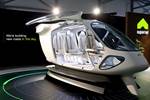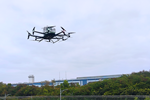Supernal debuts S-A2 eVTOL aircraft concept
V-tail, five-passenger aircraft builds on the vison of the S-A1, designed with a priority on safety and a focus on sustainability.
The S-A2 on display within the Supernal Vertiport exhibition at CES 2024 in Las Vegas. Photo Credit: Supernal LLC
Supernal LLC (Washington, D.C., U.S.) — Hyundai Motor Group’s advanced Air Mobility (AAM) company — unveiled S-A2, its electric vertical takeoff and landing (eVTOL) vehicle product concept. The pilot-plus-four-passenger vehicle marks the latest milestone in Supernal’s roadmap to commercialize safe, efficient and affordable everyday passenger air travel.
S-A2 builds on the company’s vision concept, S-A1, which it debuted in 2020, bringing together the aerospace engineering and Hyundai Motor Group automotive aesthetic design to create a new mode of transportation to get people in urban areas from point A to point B faster. Supernal aims to achieve commercial aviation safety levels and enable affordable manufacturing of its vehicles as it prepares to enter the market in 2028.
S-A2 is a V-tail aircraft designed to cruise 120 miles per hour at an altitude of 1,500 feet to meet typical city operation needs of 25- to 40-mile trips, initially. It features a distributed electric propulsion architecture and has eight all-tilting rotors. At entry into service, Supernal’s vehicle will operate at a quiet 65 decibels in VTOL phases and 45 decibels while cruising horizontally.
The vehicle is designed with a priority on safety and a focus on sustainability and passenger comfort. It has a robust airframe structure including redundant components in critical systems such as powertrain, flight controls and avionics. The all-tilting rotor configuration will power the vehicle through both the vertical lift and horizontal cruise phases of flight with efficiency. The vehicle will be manufactured leveraging Hyundai’s mass production capability with the goal of maintaining the quality and cost-effectiveness of the product.
Ben Diachun, chief technology officer of Supernal, says that the S-A2 takes advantage of emerging electric powertrain advancements which he anticipates will define the next generation of aviation. As Supernal continues to optimize its vehicle for certification, mass production and expanded use cases, the company is also focused on interior modularity and battery upgradability. This includes the ability to replace the battery module as technology advances.
Supernal’s engineering teams have also partnered with Hyundai Motor Group’s automotive designers on S-A2’s aesthetics — blending design with functionality — that aims to attract aviation operators and create the preferred AAM passenger experience. Different color palettes and materials delineate distinct pilot and passenger sections of the vehicle. Aviation-grade, energy-absorbing components are integrated into the seat frames, and contribute to the overall clean, minimalist design. Lighting transitions throughout phases of flight allow the cabin to feel larger and to provide visual cues, such as where to enter and exit the vehicle.
Luc Donckerwolke, president, chief design officer and chief creative officer, Hyundai Motor Group, lauds the S-A2 as a true representation of “auto meets aero.”
For related content, read “GKN Aerospace to provide aerospace expertise for Supernal eVTOL vehicle.”
Related Content
-
Infinite Composites: Type V tanks for space, hydrogen, automotive and more
After a decade of proving its linerless, weight-saving composite tanks with NASA and more than 30 aerospace companies, this CryoSphere pioneer is scaling for growth in commercial space and sustainable transportation on Earth.
-
Composites end markets: Automotive (2024)
Recent trends in automotive composites include new materials and developments for battery electric vehicles, hydrogen fuel cell technologies, and recycled and bio-based materials.
-
Collins Aerospace to lead COCOLIH2T project
Project for thermoplastic composite liquid hydrogen tanks aims for two demonstrators and TRL 4 by 2025.

















